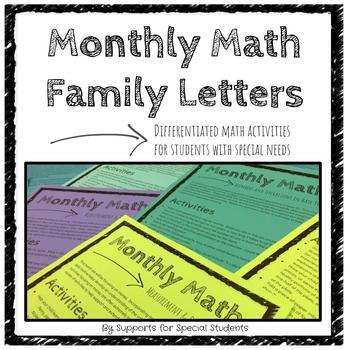Monthly Math Family Letters - Differentiated Activities for Special Education
- PDF
Description
This set of Monthly Math letters is designed to be used in an elementary special education classroom. Each letter focuses on a different domain of mathematics and includes simple, hands-on activities for families to try at home. The activities are differentiated to meet the varied needs of students in a special education program, and focus on the foundational skills needed to work towards the Common Core State Standards.
This set includes 10 letters:
Overview
Counting and Cardinality
Numbers and Operations in Base Ten
Numbers and Operations - Fractions
Operations and Algebraic Thinking - Addition and Subtraction
Operations and Algebraic Thinking - Multiplication and Division
Geometry
Measurement & Data
Measurement & Data - Money
Measurement & Data - Time
If you like this product, you may also be interested in:
Easy Data Collection for Special Education - Forever Growing Bundle
Alternative Pencil Flipbook - Writing Tool for Special Education
Seasonal Counting Growing Bundle
•••••••••••••••••••••••••••••••••••••••••••••••••••••••••••••••
Click the green star next to my picture to follow my store. All products are discounted for the first 48 hours after being listed. You don't want to miss it!
•••••••••••••••••••••••••••••••••••••••••••••••••••••••••••••••





